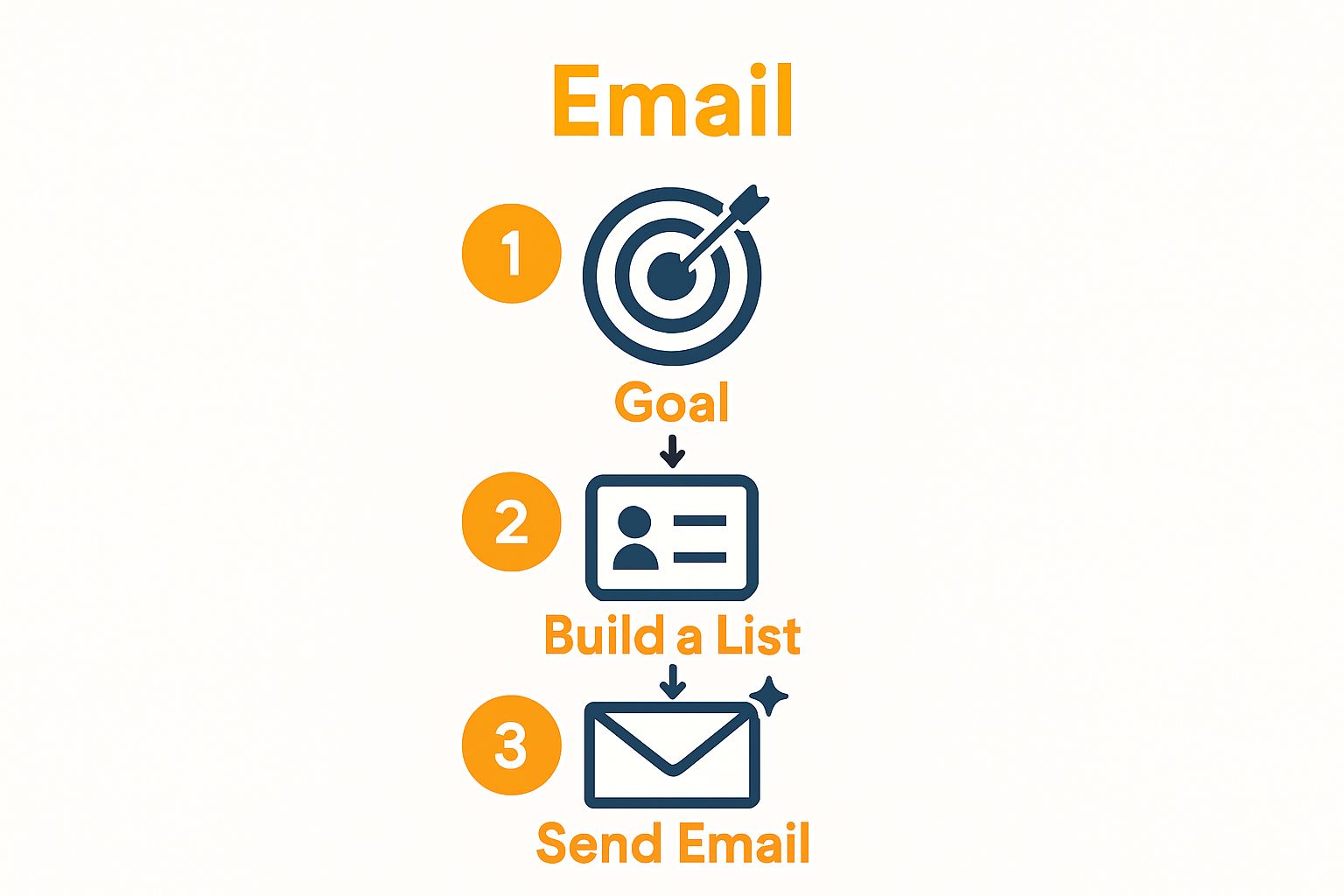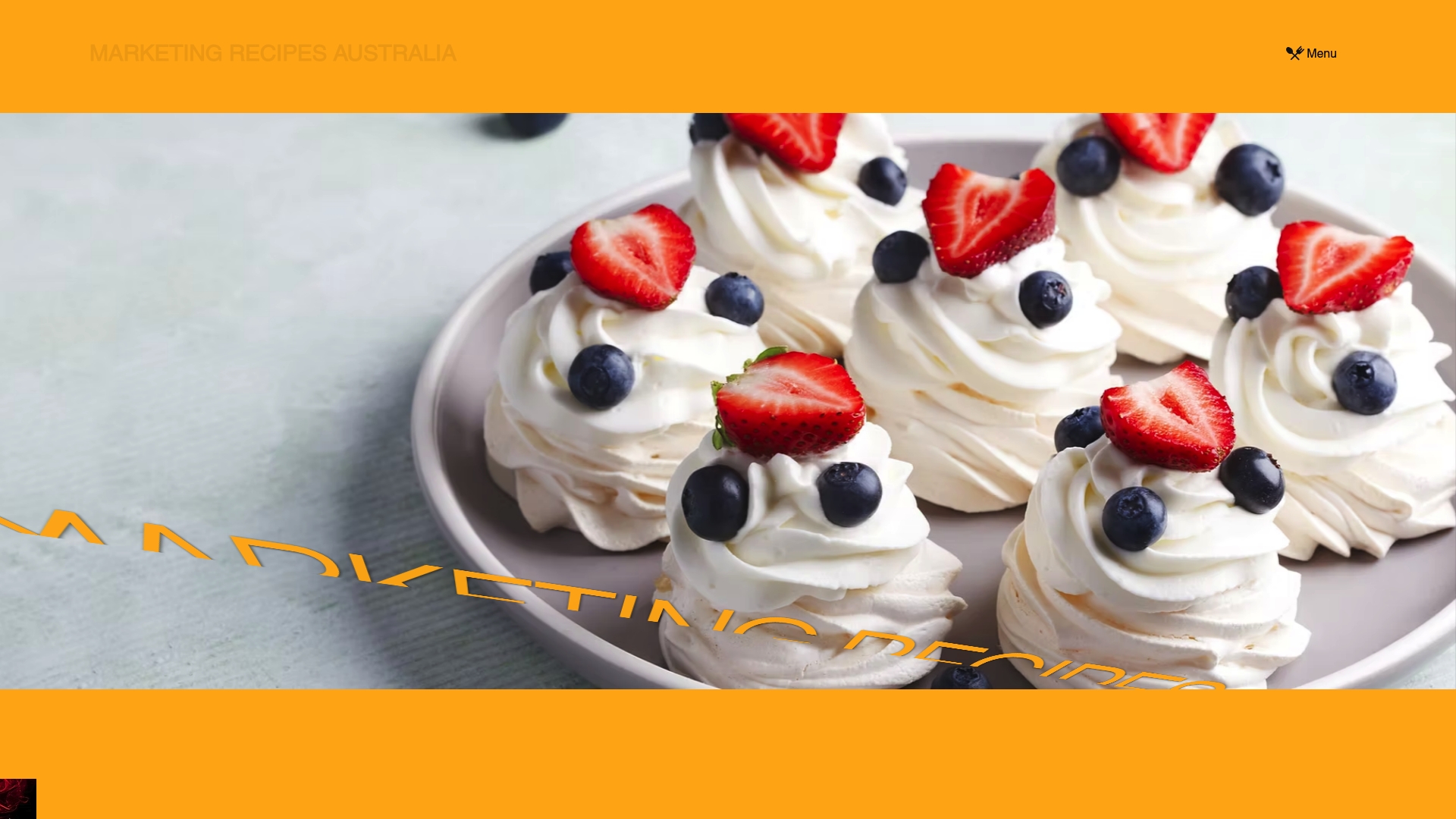Master Email Campaigns Step by Step for Regional Business
- Eddie The Chef

- Oct 10
- 11 min read

Email marketing can unlock steady growth for regional businesses and often those who do it right see a difference fast. Here is the shocker. Over 60% of emails are now first opened on mobile devices yet most local businesses are still delivering one-size-fits-all blasts that go ignored. The real secret is laser sharp strategy and tailored content that speaks straight to your true customer and makes every send actually count.
Table of Contents
Quick Summary
Key Point | Explanation |
1. Define SMART campaign objectives | Clear, specific goals ensure your email strategy aligns with business aims and drives measurable results. |
2. Build a quality email list | Prioritize organic list growth through genuine opt-ins to maintain engagement and avoid damaging your brand reputation. |
3. Create engaging email content | Design visually appealing emails with strong subject lines, clear CTAs, and personalized messaging to capture attention and drive action. |
4. Schedule emails based on audience behavior | Timing is crucial; send emails when your target audience is most likely to engage for optimal results. |
5. Continuously monitor and optimize campaigns | Analyze campaign performance metrics to refine strategies, ensuring your email marketing remains relevant and effective. |
Step 1: Define Your Campaign Goals and Objectives
Every successful email marketing journey starts with crystal clear objectives. Your campaign’s effectiveness hinges on understanding exactly what you want to achieve and why. Regional businesses often struggle with defining precise goals, which can lead to scattered, ineffective messaging that fails to resonate with their audience.
Begin by mapping out specific, measurable outcomes that align with your broader business strategy. Are you looking to drive sales for a seasonal promotion? Increase customer engagement? Build brand awareness? These objectives will serve as the north star guiding your entire email campaign design and execution.
Below is a quick reference overview of each main step in running a successful email campaign, including main purpose and outcome to help guide your planning.
Step | Purpose | Main Outcome |
Define Campaign Goals | Aligns emails with business aims | Clear, measurable objectives set |
Build Email List | Grow engaged audience | Quality, permission-based contact list built |
Design Content & Layout | Engage and inspire action | Visually appealing, relevant emails |
Schedule & Send | Optimise timing for target audience | Emails reach inbox at best time |
Monitor Performance | Measure and evaluate success | Actionable insights from metrics |
Optimise Campaigns | Improve future results | Enhanced performance over time |

Consider your current business metrics and where email marketing can create meaningful impact. For instance, a local automotive workshop might aim to increase service bookings by 20% through targeted email communications, while a regional cafe could focus on boosting weekend customer foot traffic through promotional email sequences. Learn more about crafting targeted marketing strategies that align with your specific business goals.
To effectively define your campaign objectives, ask yourself these critical questions: What specific action do you want recipients to take? How will you measure success? What key performance indicators (KPIs) matter most to your business? Your goals should be SMART: Specific, Measurable, Achievable, Relevant, and Time-bound.
For regional businesses, this means moving beyond vague aspirations to concrete, trackable outcomes. A well-defined goal might look like: “Increase online booking conversions by 15% within three months by sending targeted email campaigns to our existing customer database.” This approach transforms abstract ambitions into actionable, measurable marketing strategies that drive real business results.
Remember, your email campaign objectives should directly connect to your broader business strategy. They are not standalone tactics but integrated components of your overall marketing approach. Take time to align your email marketing goals with your business growth plans, ensuring every communication serves a strategic purpose.
Step 2: Build Your Target Email List Effectively
Building a targeted email list is the critical foundation of any successful email campaign. Regional businesses must approach list building strategically, understanding that quality trumps quantity every single time. Sending emails to uninterested recipients wastes resources and potentially damages your brand reputation.
Start by examining your existing customer database. These are individuals who already know and potentially appreciate your business. Review customer records from point of sale systems, website interactions, loyalty programs, and previous marketing efforts. Discover more about effective email marketing strategies that can transform your approach to list building.
Collection methods matter significantly. Implement multiple touchpoints where potential subscribers can opt into your email communications. Your website should feature prominent but non-intrusive signup forms. Consider offering genuine value in exchange for email addresses - this might include exclusive discounts, helpful industry insights, or early access to promotions specific to your regional business sector.
Avoid purchasing email lists at all costs. These databases are typically low quality, often containing outdated or irrelevant contacts who have not expressed interest in your business. Such practices can trigger spam filters, harm your sender reputation, and potentially breach privacy regulations. Instead, focus on organic list growth through permission-based methods that attract genuinely interested subscribers.
Segmentation becomes crucial in this process. Not all customers are identical, so your email list should reflect different customer personas. A local automotive workshop might segment between car enthusiasts, regular maintenance customers, and fleet management clients. Each segment requires tailored communication that speaks directly to their specific needs and interests.
Verify your list’s health regularly by tracking metrics like open rates, engagement levels, and bounce rates. Remove inactive subscribers periodically to maintain a clean, responsive email database. A lean, engaged list will always outperform a bloated collection of disinterested contacts.
The table below highlights common causes of underperforming email campaigns for regional businesses, paired with likely contributing factors and practical remedies directly drawn from the article guidance.
Problem | Likely Cause | Suggested Remedy |
Low open rates | Unclear goals, poor subject lines | Set SMART objectives; develop catchy, relevant subject lines |
High unsubscribe rates | Unengaged or purchased lists | Build organic lists; segment audience appropriately |
Poor mobile experience | Non-responsive design | Ensure responsive layouts; test across devices |
Low click-through rates | Unclear CTAs, generic content | Use clear CTAs; personalise messaging and segment content |
Spam complaints | Sending to uninterested users | Use permission-based list building; avoid purchased contacts |
Step 3: Design Engaging Email Content and Design
Creating compelling email content is an art form that blends strategic communication with visual appeal. For regional businesses, your email design must immediately capture attention and communicate value within seconds of opening. The first impression determines whether a recipient continues reading or deletes your message instantly.
Start by understanding your audience deeply. Your email design should reflect the personality and preferences of your specific regional customer base. A local automotive workshop will require a different visual approach compared to a boutique winery or professional services firm. Explore the nuanced world of email marketing communication to refine your approach.
Visual hierarchy becomes crucial in effective email design. Your most important message should be prominent, using strategic font sizes, bold formatting, and color contrast to guide the reader’s eye. Use professional, clean typography that remains readable across different devices. Mobile responsiveness is non-negotiable - over 60% of emails are first opened on mobile devices, so your design must adapt seamlessly.
Content structure matters immensely. Craft a compelling subject line that promises value and creates curiosity. Your opening paragraph should deliver on that promise immediately. Use concise, conversational language that speaks directly to the recipient’s needs or challenges. Break up text with short paragraphs, relevant imagery, and clear calls to action that guide the reader towards the desired outcome.
Personalisation transforms generic communications into targeted experiences. Use recipient names, reference past interactions, and segment your content to speak directly to specific customer groups. A regional cafe might send different email designs to morning coffee regulars versus weekend brunch customers, each with tailored messaging and visual approaches.
Finally, test your email design rigorously. Send test emails to different devices, check loading speeds, and ensure all links function correctly. A broken email design can instantly undermine your professional credibility. Your goal is creating an email that looks professional, feels personal, and compels the recipient to take action - whether that’s making a booking, purchasing a product, or engaging with your business.

Step 4: Schedule and Send Your Campaign
Scheduling and sending your email campaign requires strategic timing and technical precision. The moment you hit send can dramatically impact your campaign’s success, transforming a good email into a high-performing marketing tool that drives genuine business results.
Timing is everything in email marketing. Regional businesses must understand their specific audience’s digital behaviour. A cafe might find weekend morning emails more effective, while a professional services firm might see better engagement during weekday business hours. Research your audience’s typical online patterns and schedule accordingly. Explore advanced email marketing timing strategies to refine your approach.
Choose a reliable email marketing platform that offers robust scheduling and tracking capabilities. These tools provide critical features like automated sending, segmentation, and detailed performance analytics. Look for platforms that integrate smoothly with your existing customer relationship management systems, enabling seamless communication and data tracking.
Before sending, conduct comprehensive pre-send checks. Verify all links function correctly, images load properly, and the email displays correctly across different devices and email clients. Test your email on multiple platforms - desktop, mobile, and various email services like Gmail, Outlook, and Apple Mail. A single broken element can undermine your entire campaign’s credibility.
Understand your email service provider’s sending limits and reputation management systems. Sending too many emails simultaneously or to a large, unengaged list can trigger spam filters, potentially damaging your sender reputation. Start with smaller, segmented sends and gradually scale up. This approach allows you to monitor engagement and adjust your strategy dynamically.
Implement a strategic sending frequency that keeps your brand top of mind without overwhelming subscribers. Most regional businesses find success with a monthly or bi-monthly communication schedule. Pay attention to subscriber engagement metrics - open rates, click-through rates, and unsubscribe rates will indicate whether your timing and content resonate with your audience. Your goal is creating a consistent, valuable communication rhythm that subscribers anticipate and appreciate.
Step 5: Monitor Performance and Gather Insights
Monitoring your email campaign’s performance is not just about collecting numbers - it is about understanding the story behind those metrics and transforming raw data into actionable business intelligence. Performance tracking allows regional businesses to continuously refine their marketing approach and deliver increasingly targeted communications.
Focus on key performance indicators (KPIs) that directly reflect your original campaign objectives. Open rates, click-through rates, conversion rates, and unsubscribe rates provide a comprehensive view of your email campaign’s effectiveness. Learn more about interpreting email marketing metrics to make informed strategic decisions.
Utilise advanced analytics tools integrated within your email marketing platform to dive deep into subscriber behaviour. These insights go beyond surface-level statistics. Understand which content resonates most with different customer segments, what time of day generates highest engagement, and which calls to action drive tangible business results. A local automotive workshop might discover that service discount emails perform best on Tuesday afternoons, while a regional cafe might find weekend brunch promotions most effective.
Do not view metrics in isolation. Compare current campaign performance against previous campaigns and industry benchmarks. This contextual analysis helps you understand whether your results represent genuine improvement or potential areas requiring strategic adjustment. Look for patterns in subscriber interactions - are certain topics consistently generating more interest? Are specific customer segments more responsive?
Implement a systematic review process. Schedule monthly or quarterly comprehensive performance reviews where you analyse campaign metrics, discuss insights with your team, and develop responsive strategies. This approach transforms email marketing from a static communication tool into a dynamic, adaptive business growth mechanism.
Remember that continuous improvement is the ultimate goal. Each email campaign provides valuable learning opportunities. By meticulously tracking performance, segmenting audience responses, and remaining agile in your approach, you can develop increasingly sophisticated email marketing strategies that drive meaningful engagement and business growth for your regional enterprise.
Step 6: Optimize Future Campaigns Based on Results
Optimization is the critical final stage that transforms email marketing from a static activity into a dynamic, evolving strategy. Successful regional businesses view each campaign as a learning opportunity, continuously refining their approach based on real-world performance data. Explore advanced content optimization techniques to enhance your email marketing effectiveness.
Start by conducting a comprehensive campaign retrospective. Gather your team and systematically review the performance metrics from your recent email campaign. Identify what worked exceptionally well and areas that need improvement. This isn’t about criticism but strategic enhancement. A local automotive workshop might discover that technical service emails with specific maintenance tips generate higher engagement compared to generic promotional content.
Implement a structured approach to campaign iteration. Create a documented optimization framework that captures key insights from each campaign. This might include experimenting with different subject line approaches, testing varied send times, or refining audience segmentation strategies. The goal is incremental improvement that compounds over time, creating increasingly sophisticated and targeted email communications.
Consider developing a series of A/B testing protocols for future campaigns. This might involve testing different email designs, varying call-to-action placements, or exploring alternative messaging tones. By systematically experimenting with small variations, you can uncover nuanced insights that significantly improve your email marketing performance.
Develop a forward-looking optimization roadmap that aligns with your broader business objectives. This means connecting email marketing performance directly to business outcomes like customer acquisition, retention, and revenue generation. Regional businesses should view email campaigns as a strategic tool for building long-term customer relationships, not just a tactical communication method.
Remember that optimization is an ongoing process. What works today might not be as effective tomorrow. Stay curious, remain adaptable, and approach each email campaign as an opportunity to learn, grow, and better connect with your audience. Your commitment to continuous improvement will set you apart in the competitive landscape of regional business marketing.
Ready to Master Email Campaigns and Grow Your Regional Business?
You have taken the time to map out clear goals, segment your audience, and carefully craft engaging email content. Still, the hardest part is turning careful planning into business-winning results. Many regional businesses face the same challenge: it is not just about sending emails, it is about making each step count—right from setting SMART goals to optimising every message you send. Without the right expertise and a hands-on team, your emails may blend in with the noise or get lost altogether. That is where our personalised, kitchen-inspired approach becomes your secret ingredient.

Let us help you transform your next campaign into a proven growth opportunity. At Marketing Recipes Australia, you get more than just advice—you gain a full-service team with deep regional expertise. Take the guesswork out of planning, building, and tracking your emails. Discover our end-to-end marketing solutions, and see how a tailored strategy can boost your customer engagement and drive real results for your local business. Reach out today and give your campaign the attention it deserves. Your customers are waiting.
Frequently Asked Questions
What are the first steps to defining email campaign goals for my business?
Start by establishing specific, measurable outcomes aligned with your business strategy. Consider objectives like increasing sales, boosting engagement, or enhancing brand awareness. Employ the SMART criteria—Specific, Measurable, Achievable, Relevant, and Time-bound—to clarify your goals.
How can I effectively build an email list for my campaigns?
Focus on quality over quantity by examining your existing customer database and employing permission-based collection methods. Use website signup forms, offer value in exchange for email addresses, and avoid purchasing email lists to ensure you have genuinely interested subscribers.
What should I include in the design of my email content?
Create engaging email content with a clear visual hierarchy, using clean typography and mobile-responsive designs. Personalise messages based on recipient preferences and segment your audience to enhance relevance. Ensure your calls to action are clear and compelling.
How do I track the performance of my email campaigns?
Monitor key performance indicators (KPIs) such as open rates, click-through rates, and conversion rates to gauge effectiveness. Utilise analytics tools to gain insights into subscriber behavior and adjust your strategies based on what content resonates most with your audience.
Recommended
Comments